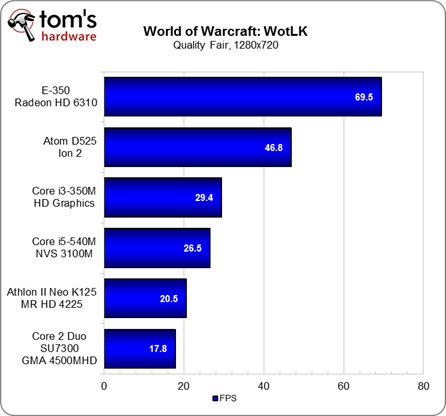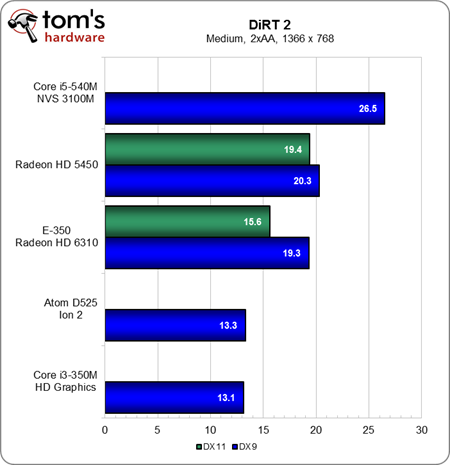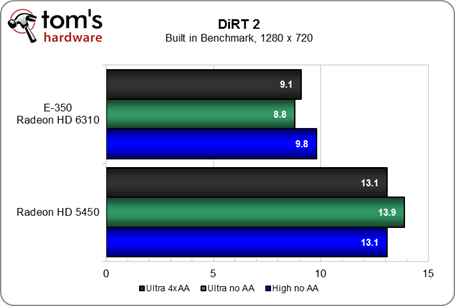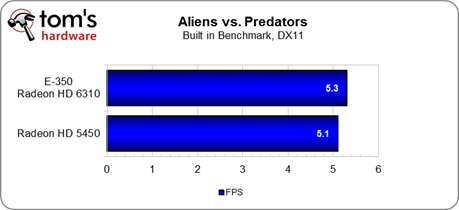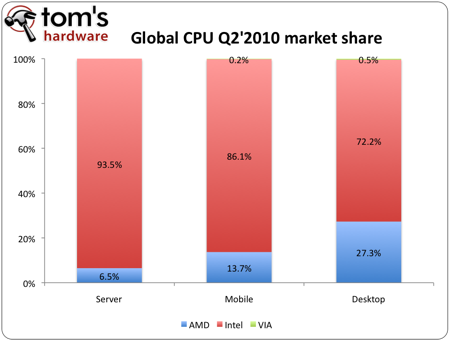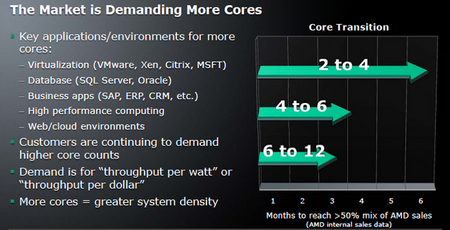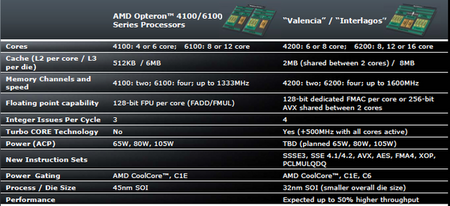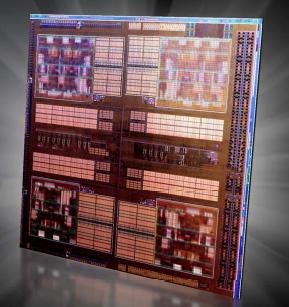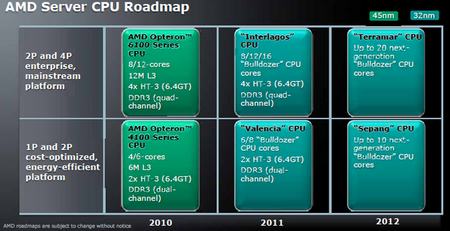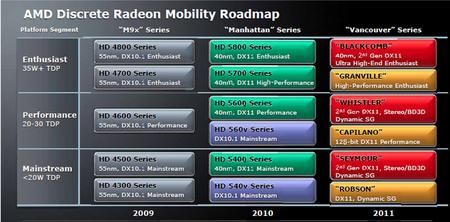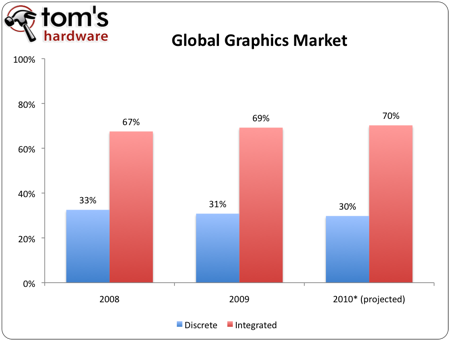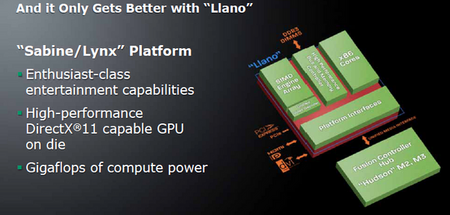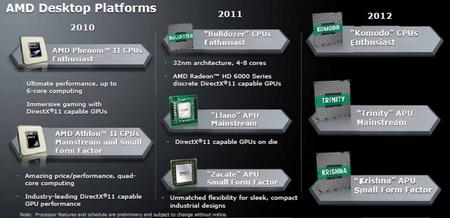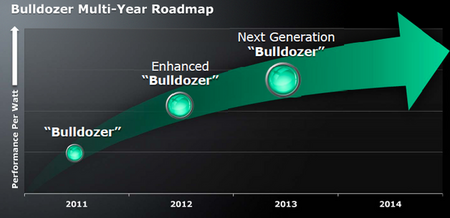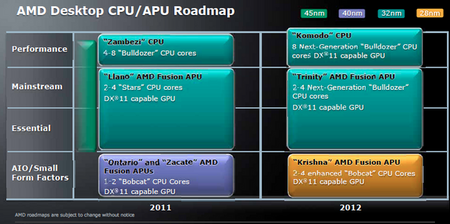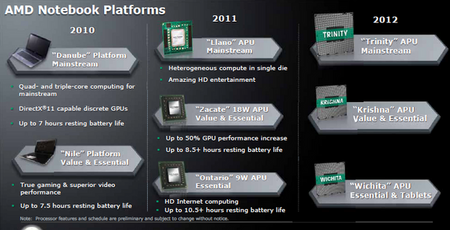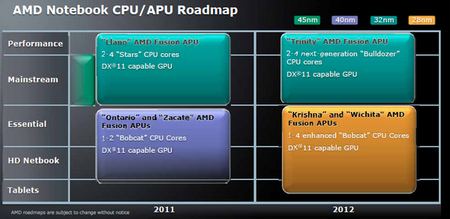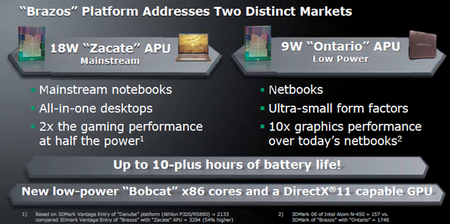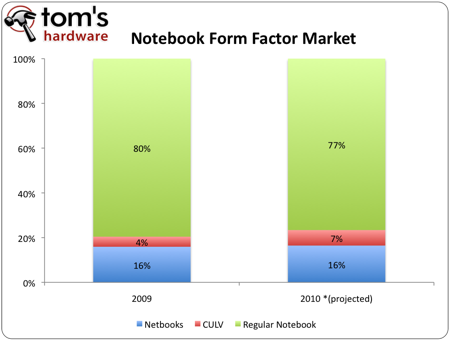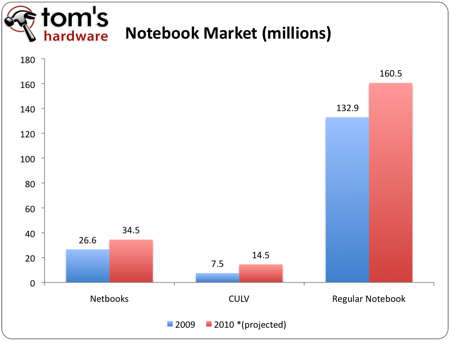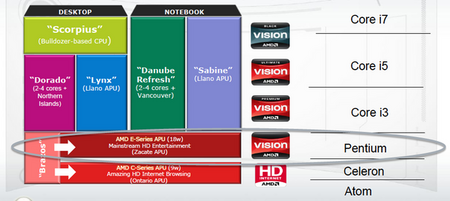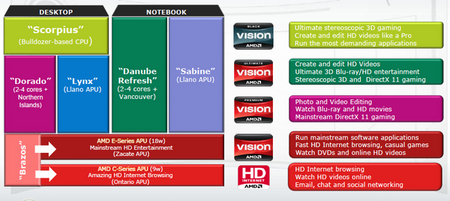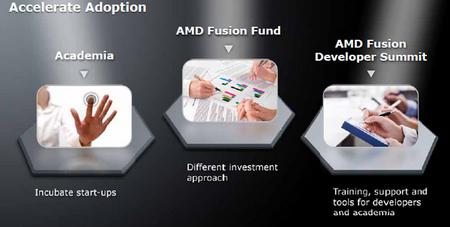
|
TopNax |
AMD Fusion: Brazos Gets Previewed: Part 2, Performance |
Benchmark Results: Graphics |
|
Benchmarks: Graphics
Overall, the new integrated Radeon HD 6310 matches our performance expectations. For the most part, think of it as a slimmed-down version of AMD's discrete Radeon HD 5450. We see that the Radeon HD 6310 scales similarly to the discrete Radeon HD 5450, though the lack of dedicated frame buffer memory hurts performance relative to the add-in card as you step up to Ultra quality.
The drop in performance using 8xAA is much more pronounced on the 6310 than the desktop 5450, again as a result of no dedicated frame buffer and slower access to system memory. |
|
CyberLink was gracious enough to give us early access to a version of MediaEspresso optimized for AMD's Fusion initiative. We should point out that optimized doesn't mean that CyberLink is shifting more weight to GPGPU processing. Instead, the company is taking advantage of new software hooks. Because of time restrictions, we were unable to get a software-based (no hardware acceleration) benchmark of the E-350. However, given what we saw with other processors, it doesn't look like we are seeing any sort of gain in shifting encoding to the GPU, even when we force the option in the software. Instead, we do see large gains in when the hardware accelerated decoding is enabled by virtue of AMD's fixed-function UVD 3.
Based on the numbers, it seems that AMD's third-generation UVD is almost as fast as Intel's decode hardware. We are told that further improvements should come by way of new drivers. |
AMD Roadmap Updates |
|
AMD Roadmap Updates AMD had its 2010 Analyst Day recently, so we felt obliged to share some of its plans for the future. Server Market
We have said it before and we will say it again, AMD is lagging in the server market. The company knows this, and has been trying to make the point that its portfolio is growing. AMD's problem is that, Intel's Xeon 5600-series CPUs incorporate all of the same technologies that have been dominating performance metrics on the desktop. AMD is weathering the storm because it is hitting decent price points, given that this is the fourth consecutive quarter we have seen CPU prices rise. Given that server purchases tends to occur in cycles, we still feel that AMD's strongest bet is with the new Bulldozer-based processors. Until those chips surface sometime in 2011, the Opteron 6000-series is AMD's only answer to Intel's onslaught (which now also includes a compelling Xeon 7500-series, too). Stop-gaps only go so far, so hopefully Bulldozer will be everything AMD promises it to be. AMD used to have a double-digit hold on the server market, and as of today, we are still looking at a single-digit existence.
On paper, Bulldozer looks impressive. AMD is all about cores and more cores. With the 6200-series (Interlagos), we are going to finally see AMD try and take the top spot for the server market. We're hoping AMD has learned its lesson about market timing. While it gave up socket compatibility for better performance scaling in the 6100-series, the company really needs to come back swinging in 2011 if it wants to retake chunks of the server market back from what could be considered an entrenched Intel position.
Graphics Market
Our earlier report on the Vancouver series was spot on. Prior to the 9th, there were only a handful reports on the Mobility Radeon HD 6000-series (code named "Vancouver"). If the "Blackcomb" part scales anything like the Mobility Radeon HD 5800 to its desktop brother, we are in for more treats on the performance side in 2011. Frankly, we are more interested in seeing how the "Seymour" and "Robson" parts perform. |
AMD Roadmap Updates, Cont. |
|
AMD Roadup Updates Cont.
Discrete and Integrated Graphics Market
AMD claims that its APU market is bigger than Intel's EPG market. Both the EPG and the APU will likely stem the growth of the discrete graphics cards somewhat as mainstream consumers become sated with a single-chip solution.
Platforms
It is as we reported on the 9th: there will be dual-, triple-, and quad-core Llano APUs out in 2011. Unfortunately, from what we understand, there is a delay in the fab process, which may push the time line back into 2H 2011. At first, AMD was optimistically calling out 1H for some Llano parts, and that doesn't seem to be the case anymore. While we have only looked at the SB750 (Hudson-M1) southbridge, the existence of M2 and M3 parts suggests that native USB 3.0 support isn't out of the question for mainstream platforms.
We now have another round of code names to cope with as we start looking past 2011 and into the APUs expected in 2012.
On the desktop and mobile side...
Komodo is the code name for the CPU design that replaces Zambezi in the performance desktop space. Given what we know about how AMD is planing to roll out CPUs in its cadence philosophy, Komodo is to be the "enhanced" version of Bulldozer with DirectX 11-class graphics (remember, Zambezi won't include graphics).
Trinity is the next evolution of the mainstream APU, displacing Llano in 2012. The most significant change will be a shift from the Stars processing cores used today to a Bulldozer-based CPU architecture. Trinity will continue shipping in dual-, triple-, and quad-core variants, though.
Krishna is will take over for Zacate, while Wichita will effectively replace Ontario. These two parts are interesting as well, since AMD plans to double max core count, while maintaining the same power specs from the previous Zacate and Ontario generation of Bobcat powered APUs. |
Final Words |
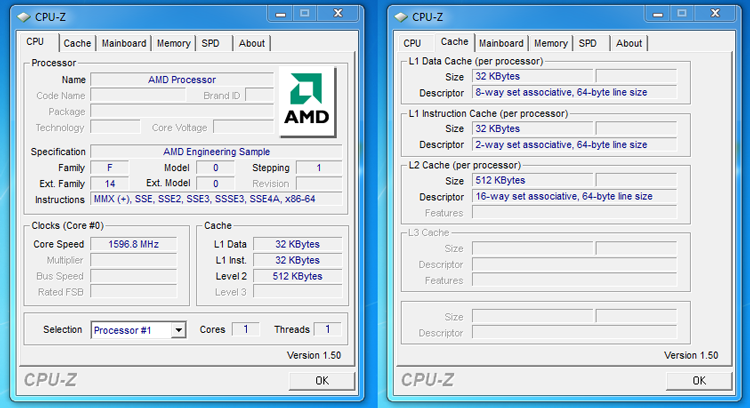
|
We got a very early look at Brazos, and AMD is offering something unprecedented: discrete GPU performance in a single-chip CPU/GPU package. Moreover, the company is offering impressive heat characteristics, given the complexity of what it is packing into a single die. We should clarify that AMD is aiming squarely for Intel's true blue CULV parts, by which we mean the UM Arrandales and previous generation of Core 2 Duo, Core 2 Solo, and Pentium ULV processors. |
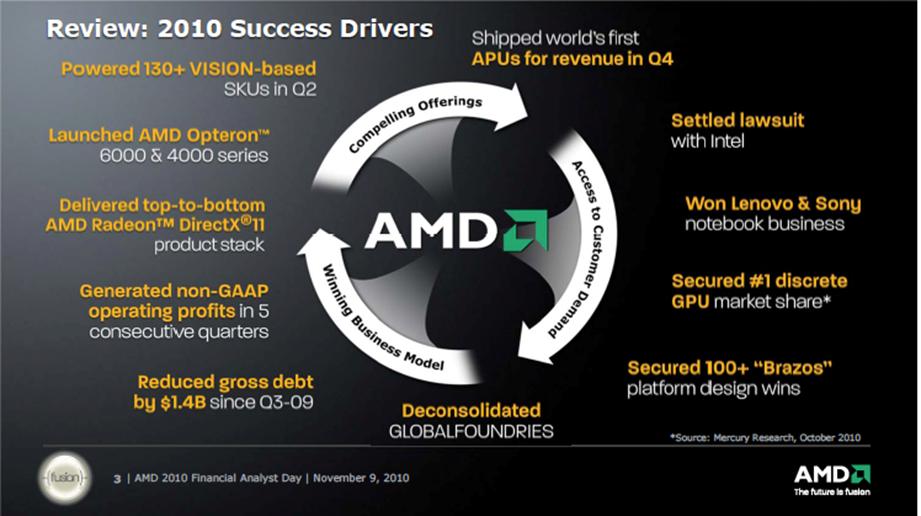
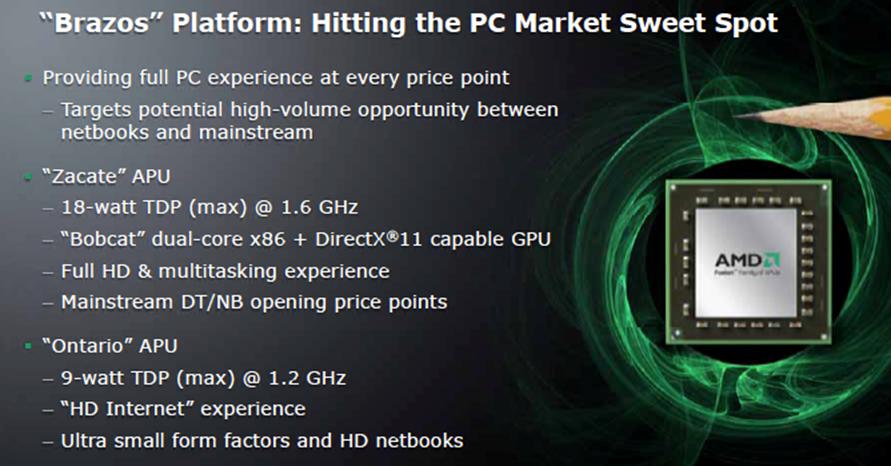
|
AMD is already touting over 100 Brazos design wins, which means we should see a slew of derivative notebook at CES. AMD is making a lot of noise with Brazos (specifically Zacate) as it seeks to usurp Intel in the fast-growing CULV market. However, AMD may have lost focus on the bigger picture, and that's a result of the company's performance-driven culture--to which we can certainly relate.
Of the three APUs that AMD chose to impress the press with, it understandably went for the one with a bit more of a performance edge. Unfortunately, while that does a lot for enthusiastic power users, it doesn't necessarily translate into volume or the bottom line. In general, AMD is still suffering in the mobile CPU market. Its last major successful mobile platform (in terms of sheer wins) was Puma. Those sold like hotcakes in the 15" form factor (we saw prices at $399 without rebates), but were relegated to budget product lines. AMD hardly saw any revenue beyond getting rid of legacy products.
If AMD is really dressed for success, it needs to also follow up quickly with Sabine and Ontario. As it stands, the company has an uphill battle on its hands. If you remove netbooks from the equation, 15" notebooks account for close to 50% of all notebook sales. The other 50% can be split up between 14" and 17" notebooks. For AMD to really hit a home run, we need to see how far Sabine has come along. These are numbers we have confirmed with many of our system vendor contacts, and they apply across the board, from HP, Acer, Lenovo, and Dell. Purely by the numbers, Zacate applies to roughly 7% of the current notebook market, while Ontario applies to ~15%, and mobile Llanos apply to over 75% of the notebook market. Thin and light notebooks, all-in-one desktops, and premium netbooks are all within Zacate's target range of $500. It is a competitive solution, but the majority of laptop sales are, frankly, elsewhere. We make this point because AMD could actually underdeliver with Zacate, overdeliver with the mobile Llano and Ontario parts, and still come out on top.
So, the big question that AMD needs to address is: how much CPU performance is enough? On a netbook, it makes little sense to pay a $100 or $200 premium in order to watch 1080p video on a 10.1" screen. On a CULV or DTR notebook, this becomes more important, since you have more desktop real estate to play games and the environment conducive to enjoy multimedia. Right now, these notebooks have CPU performance to spare. AMD is pairing the Zacate APUs against the previous generation of CULV-processors from Intel: Core 2 Duo, Core Duo, and Pentium. However, according to system vendors, these notebooks will be phased out by the end of Q1'2011, which means the Zacate APUs are going to have to face off against the newer 18W UM Arrandales. These new ULV processor from Intel all carry some serious CPU horsepower. We maintain that AMD is going to need to convince system builders that good graphics performance is better than having an overabundance of processor horsepower. AMD finally achieved a CPU design win last quarter with Sony, so the only holdout is Apple. AMD needs to get this conversation going at the consumer level, because no one is really thinking this way (though they should--we see this all of the time in the desktop space, which is much more gaming-oriented). We are currently playing in an Intel sandbox, where CPU performance is still remains at the top of the agenda list.
Available (and relevant) software needs to be driven toward GPGPU if AMD really wants to claim that having acceptable CPU and GPU performance is better than having goobs of CPU horsepower. Unfortunately, we are not at that point. AMD recently started improving its developer relations. The new AMD Fusion developer "trust fund" is actually a great way to start chipping away at the current CPU-heavy mentality. |
|
Home Previous AMD page Intel page Next |
|
Cyberlink MediaEspresso 6 |
Decode |
Encode |
Decode and Encode |
None |
|
Atom D525 |
0:48 |
3:41 |
0:49 |
3:41 |
|
Athlon II Neo K125 |
1:10 |
N/A |
N/A |
3:43 |
|
Core 2 Duo SU7300 |
N/A |
N/A |
N/A |
2:11 |
|
E-350 |
1:02 |
1:23 |
1:01 |
*time restricted* |
|
Core i3-350M |
0:48 |
1:18 |
0:48 |
1:15 |
|
Core i5-540M |
0:48 |
1:02 |
0:41 |
1:03 |
